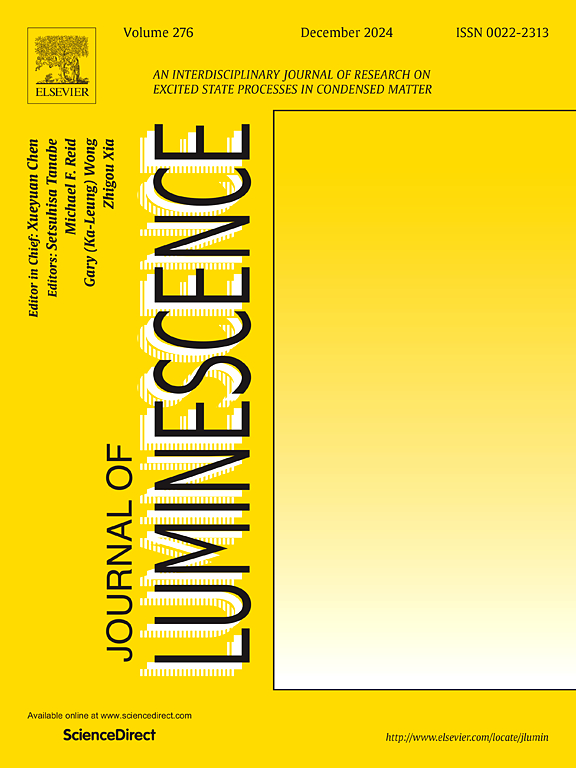Synthesis and luminescence properties of deep-red-emitting LiAlSi2O6:Mn4+ for plant growth lighting
IF 3.3
3区 物理与天体物理
Q2 OPTICS
引用次数: 0
Abstract
Light can improve the growth and development of most plants, and the red/deep-red light in the 600–760 nm region is very good for phytochrome red and phytochrome far-red of plants, causing a great interest in the research and development of the deep-red-emitting luminescence materials. In this work, a pure phase LiAlSi2O6:Mn4+ with monoclinic crystal structure and only luminous center (Mn4+) is synthesized successfully in air. The excitation spectrum of LiAlSi2O6:Mn4+ covers the region from 220 to 550 nm owing to the O2− - Mn4+ charge transfer and the 4A2g → 4T1g and 4T2g transitions of Mn4+. We observe the deep-red emission of LiAlSi2O6:Mn4+ with emission peak at ∼663 nm in the range of 600–850 nm due to the transitions 2Eg → 4A2g of Mn4+ and analyze the luminous mechanism. The optimal doping concentration of Mn4+ (0.1mol%) is determined by the concentration dependent emission spectra. We analyze the concentration quenching mechanism and investigate the lifetimes of LiAlSi2O6:Mn4+ with different Mn4+ concentration. The good thermal stability of LiAlSi2O6:Mn4+ is confirmed via the temperature dependent emission spectra. The potential applications of LiAlSi2O6:Mn4+ in plant growth LED lighting are estimated by comparison of spectral properties of LiAlSi2O6:Mn4+ and plant.
植物生长照明用深红色发光材料LiAlSi2O6:Mn4+的合成及发光性能
光可以促进大多数植物的生长发育,600 - 760nm区域的红光/深红光对植物的光敏色素红和光敏色素远红非常有利,引起了人们对深红色发光材料的研究和开发的极大兴趣。本文成功地在空气中合成了具有单斜晶型结构的纯相LiAlSi2O6:Mn4+。由于O2−- Mn4+的电荷转移和Mn4+的4A2g→4T1g和4T2g跃迁,LiAlSi2O6:Mn4+的激发光谱覆盖了220 ~ 550 nm的区域。在600 ~ 850 nm范围内,由于Mn4+的2Eg→4A2g跃迁,LiAlSi2O6:Mn4+在~ 663 nm处产生了深红色发光,并分析了发光机理。通过浓度依赖性发射光谱确定了Mn4+的最佳掺杂浓度(0.1mol%)。分析了浓度猝灭机理,研究了不同Mn4+浓度下LiAlSi2O6:Mn4+的寿命。通过温度相关发射光谱证实了LiAlSi2O6:Mn4+具有良好的热稳定性。通过对比LiAlSi2O6:Mn4+与植物的光谱特性,估计了LiAlSi2O6:Mn4+在植物生长LED照明中的潜在应用。
本文章由计算机程序翻译,如有差异,请以英文原文为准。
求助全文
约1分钟内获得全文
求助全文
来源期刊

Journal of Luminescence
物理-光学
CiteScore
6.70
自引率
13.90%
发文量
850
审稿时长
3.8 months
期刊介绍:
The purpose of the Journal of Luminescence is to provide a means of communication between scientists in different disciplines who share a common interest in the electronic excited states of molecular, ionic and covalent systems, whether crystalline, amorphous, or liquid.
We invite original papers and reviews on such subjects as: exciton and polariton dynamics, dynamics of localized excited states, energy and charge transport in ordered and disordered systems, radiative and non-radiative recombination, relaxation processes, vibronic interactions in electronic excited states, photochemistry in condensed systems, excited state resonance, double resonance, spin dynamics, selective excitation spectroscopy, hole burning, coherent processes in excited states, (e.g. coherent optical transients, photon echoes, transient gratings), multiphoton processes, optical bistability, photochromism, and new techniques for the study of excited states. This list is not intended to be exhaustive. Papers in the traditional areas of optical spectroscopy (absorption, MCD, luminescence, Raman scattering) are welcome. Papers on applications (phosphors, scintillators, electro- and cathodo-luminescence, radiography, bioimaging, solar energy, energy conversion, etc.) are also welcome if they present results of scientific, rather than only technological interest. However, papers containing purely theoretical results, not related to phenomena in the excited states, as well as papers using luminescence spectroscopy to perform routine analytical chemistry or biochemistry procedures, are outside the scope of the journal. Some exceptions will be possible at the discretion of the editors.
 求助内容:
求助内容: 应助结果提醒方式:
应助结果提醒方式:


